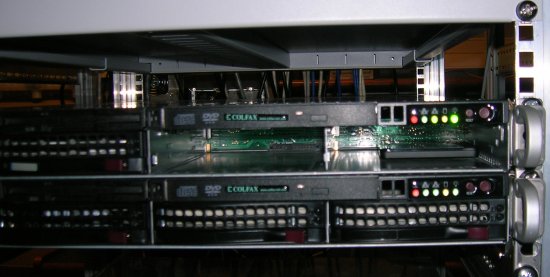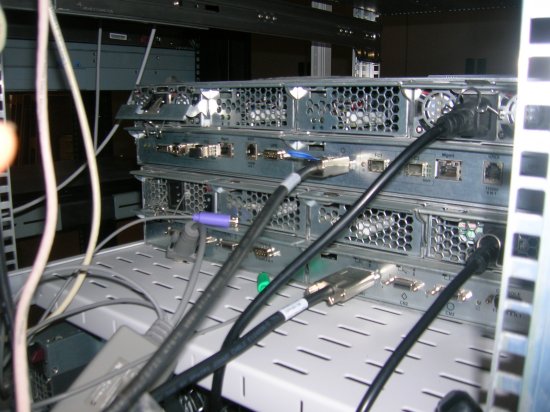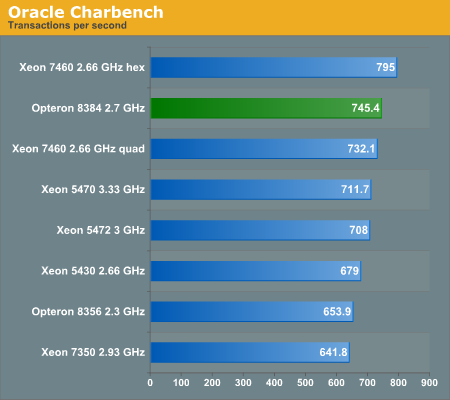The Best Server CPUs Compared, Part 1
by Johan De Gelas on December 22, 2008 10:00 PM EST- Posted in
- IT Computing
ERP & OLTP Benchmark 2: Oracle Charbench (32-bit Windows 2003 EE)
- Memory: Custom, SGA size =1536MB, PGA size = 512MB.
- Sizing: Processes = 300.
- Connection Mode: Dedicated Server Mode
Although Oracle Swingbench is freely available, it has not been easy to get repeatable benchmarks. Oracle tunes itself constantly, and as Swingbench is somewhat similar to TPC-C, it requires a heavy disk subsystem to avoid being completely disk I/O bottlenecked. That is why we test with only one CPU: the combination of a superfast Intel SLC SSD taking care of the logs and a six disk RAID-0 set for the data is good enough to ensure that one quad-core CPU can reach up to 80% CPU load. We also repeat the test four times and only report the average of the last three tests to measure with "warm caches".
Here is a look in our lab. First, we plug the Intel X25-E Extreme SATA drive into the 3.5" drive case of our Colfax/Supermicro servers. This disk contains all the logs. This setup looks like this:

An SSD drive completely lost in a 3.5 inch hard disk cage.
The data is stored on a Promise J300s that is connected by a 12Gbit/s Infiniband to an Adaptec 5805 RAID controller, which is plugged into our servers. The Promise J300S contains a RAID-0 set of six 15000RPM Seagate SAS 300GB disks (one of the fastest hard disks you can get). The Adaptec 5805 is a pretty fast RAID card, as it is equipped with a dual-core Intel IOP 348 at 1.2GHz and 512MB of DDR2. This RAID controller won't quickly become a bottleneck. Below you see the fast Infiniband x4 wideport SAS connection from the Promise DAS to our servers.

The only way to get the necessary disk spindles for our 1U servers…
Only then can we get results that are not I/O bound but CPU bound… unless we use more than one CPU.

The 45nm quad-core Opteron gets relatively close to the mighty Xeon 7460, which has a huge L3. It is remarkable how even the 3.33GHz Xeon is not able to defeat the latest Opteron.










29 Comments
View All Comments
Bruce Herndon - Tuesday, December 23, 2008 - link
I'm surprised by your comments. You claim that VMmark is a CPU/memory-centric benchmark. If I look at the raw data in the VMmark disclosure for Dell's R905 score of 20.35 @ 14 tiles, I see that the benchmark is driving 250-300 MB/s of disk IO across several HBAs and storage LUNs. This characteristic scales with the various systems mentioned in the article.As a designer of VMmark, I happen to know that both storage bandwidth (for the fileserver) and latency (for mail and database)are critical to acheiving good VMmark scores. Furthermore, the webserver drives substantial network IO. The only purely CPU-centric component to VMmark is the javaserver. Overall, the benchmark does exercise the entire virtualization solution - hypervisor, CPU, memory, disk, and network.
cdillon - Tuesday, December 23, 2008 - link
While SAS and Infiniband share some connectors and obtain similar data rates, they are incompatible technologies with two different purposes. Infiniband can be used for disk shelf connections, but it is less common and definitely not the case here. You should not call the connection between the Adaptec 5805 controller and the disk shelf an "Infiniband connection", even if it is using Infiniband connectors and cables, it is simply an SAS connection.JohanAnandtech - Tuesday, December 23, 2008 - link
Well, the physical layer is Infiniband, the used protocol is SCSI. I can understand calling it an "infiniband connection" maybe confusing, but the cable is an infiniband cable.shank15217 - Friday, December 26, 2008 - link
Anand, I think the above poster is right. The Adaptec RAID 5805 uses SFF-8087 connectors but the protocol is SSP (Serial SCSI Protocol). Infiniband is a physical layer protocol that shares the same connector as SAS but they are not the same. Nothing in the Adaptec RAID 5805 spec mentions Infiniband as a supported protocol.http://www.adaptec.com/en-US/products/Controllers/...">http://www.adaptec.com/en-US/products/C...ers/Hard...
niva - Tuesday, December 23, 2008 - link
I'm not sure you can run your same ol benchmark for rendering, and I'd really like more insight into what you guys are rendering and if it's indeed using all 16/24(six core 4 point system)/32(hyperthreading) cores on the system.What renderer, what scene, details details...
These chips get gobbled up by render farms and this is indeed where they can really flex their muscles to the fullest.
JohanAnandtech - Tuesday, December 23, 2008 - link
Just click on the link under "we have performed so many times before" :-)akinneyww - Tuesday, December 23, 2008 - link
I read DailyTech and anandtech.com to keep up with the latest in IT. I appreciate the thought that has gone into putting together this article. I would like to see more articles like this one.Jammrock - Tuesday, December 23, 2008 - link
The VMware results shocked me the most. I know AMD has been working hard on the virtualization sector and it looks like their work has paid off.classy - Tuesday, December 23, 2008 - link
With the rapid increase of virtualization, AMD is looking really strong. We have begun using 3.5 Vmware and are expanding the use of it. Virtualization is truly becoming a big thing in server choice.